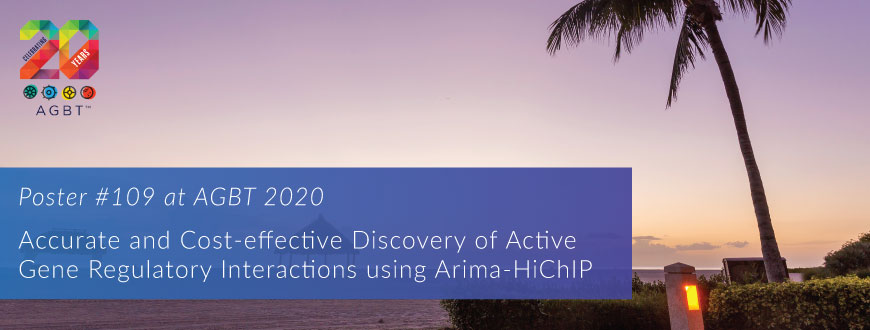
Abstract:
Precise spatiotemporal control of gene regulation is fundamental to normal biological processes and the development of disease. Therefore, detection of gene regulatory interactions is a critical component of understanding the biology of gene regulatory elements. Proximity ligation assays coupled with NGS provide a means to measure chromatin interactions within the nucleus. For example, Hi-C measures the frequency of genomic interactions at a genome-wide scale, and has become a mainstream technology for detecting genome structures ranging from genomic compartments, TADs, to chromatin loops, collectively undercovering a structural framework for gene regulation. Despite this utility, HiC is a genome-wide sequencing assay with relatively increased costs for high resolution analyses (>600M reads). Furthermore, HiC doesn’t directly enrich for gene regulatory interactions, such as those between promoters and enhancers. To address this and build upon our existing Arima-HiC kit platform, we have developed Arima-HiChIP. Arima-HiChIP integrates our Arima-HiC technology with ChIP-seq, thereby enriching for gene regulatory interactions associated with active regulatory elements. The optimized Arima-HiChIP workflow begins with ~2 million cells, and can be completed in 3 days.
Our Arima-HiChIP workflow is currently designed for integration with Covaris truChIP chromatin shearing kit and focused-ultrasonicators for chromatin shearing. We have optimized the Arima-HiChIP workflow for high resolution analysis of gene regulatory interactions associated with histone modifications, such as H3K27ac or H3K4me3, with reduced sequencing requirements (<200M reads). We have also built-in QC assays for the HiC portion of the workflow, chromatin shearing efficiency, ChIP enrichment, and library complexity. On the bioinformatics side, we have validated two open-source HiChIP analysis pipelines, MAPS and FitHiChIP. From extensive analyses of public and internal HiChIP datasets, we propose a new standardized framework and
metrics for analytical QC of HiChIP data. We aim to expand our Arima-HiChIP technology towards optimized protocols for analysis of transcription factors and low input samples.
Precise spatiotemporal control of gene regulation is fundamental to normal biological processes and the development of disease. Therefore, detection of gene regulatory interactions is a critical component of understanding the biology of gene regulatory elements. Proximity ligation assays coupled with NGS provide a means to measure chromatin interactions within the nucleus. For example, Hi-C measures the frequency of genomic interactions at a genome-wide scale, and has become a mainstream technology for detecting genome structures ranging from genomic compartments, TADs, to chromatin loops, collectively undercovering a structural framework for gene regulation. Despite this utility, HiC is a genome-wide sequencing assay with relatively increased costs for high resolution analyses (>600M reads). Furthermore, HiC doesn’t directly enrich for gene regulatory interactions, such as those between promoters and enhancers. To address this and build upon our existing Arima-HiC kit platform, we have developed Arima-HiChIP. Arima-HiChIP integrates our Arima-HiC technology with ChIP-seq, thereby enriching for gene regulatory interactions associated with active regulatory elements. The optimized Arima-HiChIP workflow begins with ~2 million cells, and can be completed in 3 days.
Our Arima-HiChIP workflow is currently designed for integration with Covaris truChIP chromatin shearing kit and focused-ultrasonicators for chromatin shearing. We have optimized the Arima-HiChIP workflow for high resolution analysis of gene regulatory interactions associated with histone modifications, such as H3K27ac or H3K4me3, with reduced sequencing requirements (<200M reads). We have also built-in QC assays for the HiC portion of the workflow, chromatin shearing efficiency, ChIP enrichment, and library complexity. On the bioinformatics side, we have validated two open-source HiChIP analysis pipelines, MAPS and FitHiChIP. From extensive analyses of public and internal HiChIP datasets, we propose a new standardized framework and
metrics for analytical QC of HiChIP data. We aim to expand our Arima-HiChIP technology towards optimized protocols for analysis of transcription factors and low input samples.
Download the Poster
Covaris
www.covaris.com
info@covaris.com
www.covaris.com
info@covaris.com
Arima Genomics
www.arimagenomics.com
www.arimagenomics.com

